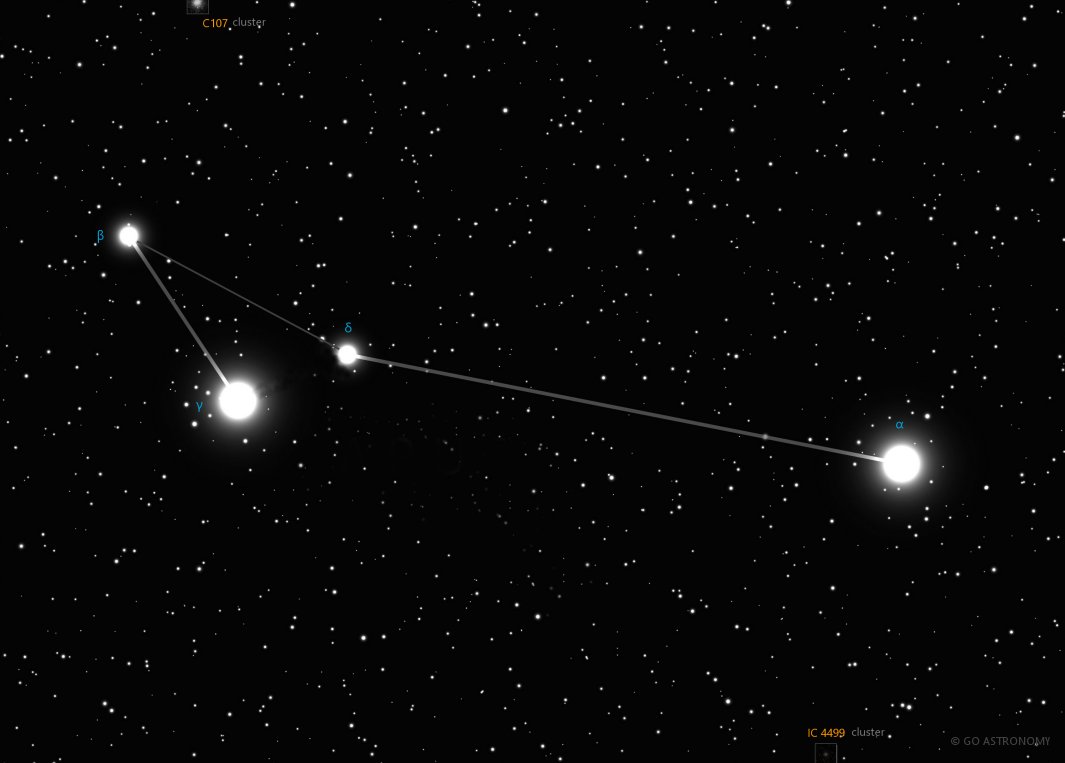Apus, the Bird-of-Paradise (Aps)
(APE-us)
The Southern constellation of Apus, the Bird-of-Paradise, is best viewed in Summer during the month of July.
Apus is the 67th largest constellation. It's brightest star is Apodis at magnitude 3.80. The boundary of the Apus constellation contains 2 stars that host known exoplanets.
Apus is a circumpolar constellation, so is visible year-round in the Southern hemisphere. Conversely, it is not visible in the opposite hemisphere.
- Pronunciation:
- APE-us
- Meaning:
- Bird-of-Paradise
- Genitive:
- Apodus
- Abbreviation:
- Aps
- Constellation Family:
- Bayer
- Hemisphere:
- Southern
- Quadrant:
- SQ3
- Visibility:
- 5° N - 90° S
- Best viewing month*:
- July
- Area:
- 206 sq. degrees
- Size:
- 67th largest
- Circumpolar** (N=northern, S=southern):
- S circumpolar
- Right Ascension (avg):
- 16h 8m
- Declination (avg):
- -76°
- Brightest star:
- Apodis (3.80)
- Stars with planets:
- 2
- Messier objects:
- |
Brightest Stars in Apus
The 10 brightest stars in the constellation Apus by magnitude.
- Star
- Magnitude
- Spectral class
- Alpha Apodis (α Aps)
- 3.83
- K5III
- Gamma Apodis (γ Aps)
- 3.86
- K0IV SB
- Beta Apodis (β Aps)
- 4.23
- K0III
- Delta Apodis (δ1 Aps)
- 4.68
- M4-M5III
- Zeta Apodis (ζ Aps)
- 4.76
- K1III
- Eta Apodis (η Aps)
- 4.89
- A2m
- Epsilon Apodis (ε Aps)
- 5.06
- B4V
- Delta Apodis (δ2 Aps)
- 5.27
- K3III
- R Apodis (R Aps)
- 5.37
- K4III
- Iota Apodis (ι Aps)
- 5.39
- B8/B9Vn
Star Clusters in Apus
The most notable and easy-to-find star clusters in the constellation Apus . Also see all star clusters.
Galaxies in Apus
The most notable galaxies in the constellation Apus. Also see all galaxies.
The Cosmic Bird of Paradise
Apus is a small, faint constellation located in the Southern Hemisphere. Despite its modest appearance and lack of bright stars, Apus contains several notable deep sky objects and holds a unique place in celestial history and nomenclature. This constellation represents the "Bird of Paradise," a creature of legend and beauty.
History and Mythology
Unlike many of the other 88 constellations, Apus doesn't have roots in ancient Greek or Roman mythology. Instead, it was introduced during the era of exploration in the 16th century by European explorers and navigators. The name 'Apus' is derived from the Greek 'Apo Ouranou' which translates to 'from the sky.' Dutch navigators Pieter Dirkszoon Keyser and Frederick de Houtman originally cataloged Apus and its neighboring constellations.
Location and Features
Apus is situated in the third quadrant of the Southern Hemisphere and is best visible at latitudes between +5? and -90?. The constellation is bordered by Triangulum Australe, Circinus, Musca, Chamaeleon, Octans, Pavo, and Ara. Despite having no stars brighter than the fourth magnitude, it is home to several interesting deep-sky objects.
The brightest star in Apus is Alpha Apodis, a binary system comprising of two yellow giant stars that orbit each other over a period of 880 years. The system, located about 411 light-years from Earth, has an apparent magnitude of 3.8. Another notable star system in Apus is Gamma Apodis, a spectroscopic binary star system composed of two giant stars.
Deep Sky Objects
Apus may not be renowned for its bright stars, but it does host a number of notable deep-sky objects. One such object is IC 4499, a globular cluster located approximately 158,200 light years from the Earth, with an apparent magnitude of 10.6. This makes it a challenging target for amateur astronomers, requiring a mid-sized telescope to resolve.
The constellation also contains several notable galaxies including the spiral galaxy NGC 6101, and a pair of interacting galaxies known as NGC 6392 and NGC 6392A. These galaxies are incredibly distant and faint, thus best suited to observation by more advanced amateur astronomers using larger telescopes.
Observing Apus
Due to its southern location and faint stars, Apus can be somewhat challenging for amateur astronomers, particularly those in the Northern Hemisphere. However, for those located in the Southern Hemisphere, it can be seen between April and June.
* Constellation shown for northen hemisphere skies. For the southern hemisphere, constellations appear rotated 180 degrees (upside-down and left-right reversed) from what is shown. Remember that seasons are reversed too - summer in northern latitudes is winter in southern latitudes.
** Circumpolar constellations are visible year-round in the hemisphere listed (and not at all in the opposite hemisphere).





